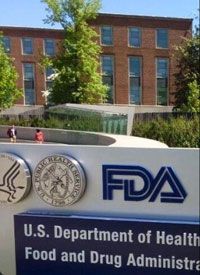Ninlaro FDA Approved Early to Treat Multiple Myeloma
Ninlaro (ixazomib) has been approved by the FDA in combination with Revlimid (lenalidomide) and dexamethasone as a treatment for patients with multiple myeloma who received at least one prior therapy.
FDA

Ninlaro (ixazomib) has been approved by the FDA in combination with Revlimid (lenalidomide) and dexamethasone as a treatment for patients with multiple myeloma who received at least one prior therapy.
Arriving 4 months ahead of schedule, the decision was based on data from the 722-patient phase III TOURMALINE-MM1 trial, which showed a median progression-free survival (PFS) of 20.6 months with Ninlaro plus Revlimid and dexamethasone compared with 14.7 months with Revlimid and dexamethasone alone.
“As we learn more about the underlying biology of multiple myeloma, we are encouraged to see the development of new ways to treat this disease,” Richard Pazdur, MD, director of the Office of Hematology and Oncology Products in FDA’s Center for Drug Evaluation and Research, said in a statement. “Today’s approval is the third drug for multiple myeloma approved this year and provides patients with a new oral treatment that slows disease progression when other therapy has failed.”
In the pivotal TOURMALINE-MM1 study, 722 patients were randomized to receive lenalidomide and dexamethasone alone (n = 362) or with ixazomib (n = 360). Ninlaro was administered orally at 4 mg on days 1, 8, and 15. Revlimid was administered orally at 25 mg on days 1 to 21 and dexamethasone was administered orally at 40 mg on days 1, 8, 15, and 22.
The median age of patients was 66 years. Overall, 88% of patients were ISS stage I/II and 19% had high-risk cytogenetics by FISH. A majority of patients (59%) had received 1 prior therapy, with 77% having relapsed multiple myeloma. Prior therapies included bortezomib (69%), thalidomide (45%), and lenalidomide (12%).
An independent data monitoring committee assessed the primary endpoint of PFS at a prespecified interim analysis in February 2015. Given the benefits seen with Ninlaro, enrollment in the trial was stopped. Secondary endpoints of the study included objective response rate (ORR), safety, and overall survival, which was not yet mature at the time of the analysis.
At the interim analysis, the median follow-up in the Ninlaro arm was 14.8 months. Overall, there was a 35% reduction in the risk of progression or death with ixazomib (HR, 0.74; 95% CI, 0.59—0.94; P = .012). For those with high-risk cytogenetics, the benefit with Ninlaro was more pronounced, with a 46% improvement in PFS (HR, 0.54). Median PFS was similar in those with high-risk cytogenetics compared with the full population.
The ORR with Ninlaro was 78.3% compared with 71.5% for Revlimid and dexamethasone alone (odds ratio [OR], 1.44; P = .035). The complete response rate with Ninlaro was 11.7% versus 6.6% with the doublet (OR, 1.87; P = .019). The rate of very good partial response or better was 48.1% versus 39.0%, with and without Ninlaro, respectively (OR, 1.45; P = .014).
The median time to response was shorter with Ninlaro (1.1 vs 1.9 months). Additionally, the duration of response was nearly 5 months longer with the proteasome inhibitor (20.5 vs 15.0 months). At the time of the analysis, half of patients remained on treatment (55% vs 52%).
Grade ≥3 adverse events (AEs) occurred in 68% of patients treated with Ninlaro versus 61% for those who received Revlimid and dexamethasone alone. Serious AEs occurred in 40% of patients treated with Ninlaro compared with 44% without the proteasome inhibitor. AEs resulted in treatment discontinuation for 13% of patients in the ixazomib triplet arm versus 11% for the two agents alone.
The most frequently reported grade ≥3 hematologic AEs with Ninlaro versus without were neutropenia (19% vs 16%, respectively), anemia (9% vs 13%), thrombocytopenia (13% vs 5%), and pneumonia (6% vs 8%). The most frequent all-grade gastrointestinal AEs for the triplet versus doublet were diarrhea (42% vs 36%) and vomiting (22% vs 11%).
All-grade peripheral neuropathy occurred in 28% of patients treated with Ninlaro compared with 21% without. Grade 3 peripheral neuropathy was the same in each arm (2%). Skin rash events occurred in 35% of patients treated with Ninlaro versus 21% in the doublet arm.
Fewer cases of renal failure were seen with Ninlaro (4% vs 6%). Cardiac events were similar between the arms. Heart failure was seen in 4% of patients treated with Ninlaro versus 3% without. Grade ≥3 cardiac failure was the same between each arm (2%).
In addition to Ninlaro, the FDA has also approved the HDAC inhibitor panobinostat (Farydak) and the CD38-directed antibody daratumumab (Darzalex) within the past 12 months. Adding further to the onslaught of new therapies for multiple myeloma, an application for elotuzumab (Empliciti) in combination with Revlimid and dexamethasone is also pending a decision from the FDA.
In addition to the MM1 study, the TOURMALINE clinical trial program contains four other phase III studies. In the MM2 trial, the combination of Ninlaro, Revlimid, and dexamethasone is being explored in newly diagnosed patients with multiple myeloma. The MM3 and MM4 studies are investigating maintenance therapy with Ninlaro in patients who have or have not undergone an autologous stem cell transplant.
Moreau P, Masszi T, Grzasko N, et al. Ixazomib, an Investigational Oral Proteasome Inhibitor (PI), in Combination with Lenalidomide and Dexamethasone (IRd), Significantly Extends Progression-Free Survival (PFS) for Patients (Pts) with Relapsed and/or Refractory Multiple Myeloma (RRMM): The Phase 3 Tourmaline-MM1 Study (NCT01564537). 2015 ASH Annual Meeting; Orlando, FL; December 5-8, 2015. Abstract 727.
Shared Model of Care Post-HCT Offers Safe Follow-Up, Reduces Patient Burden
Published: March 19th 2025 | Updated: March 19th 2025Alternating post-HCT care between specialized facilities and local cancer centers produced noninferior non-relapse mortality and similar quality of life to usual care.


